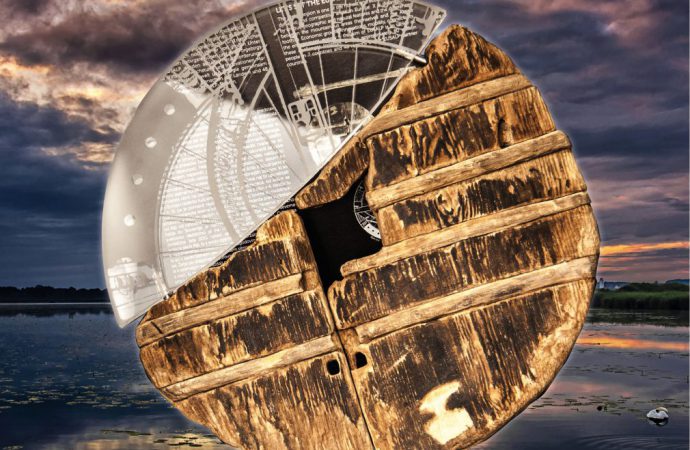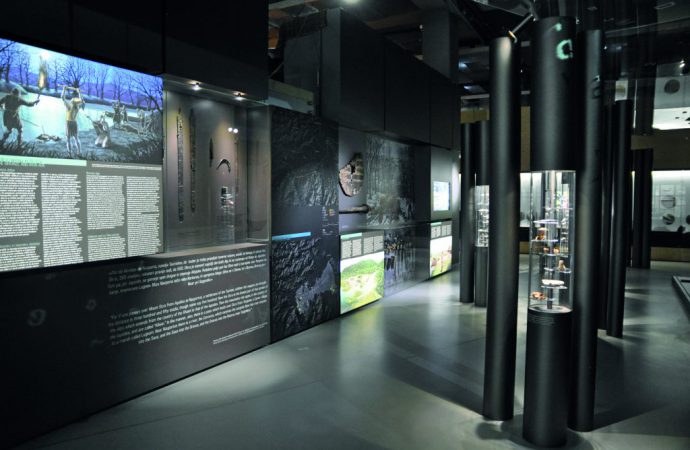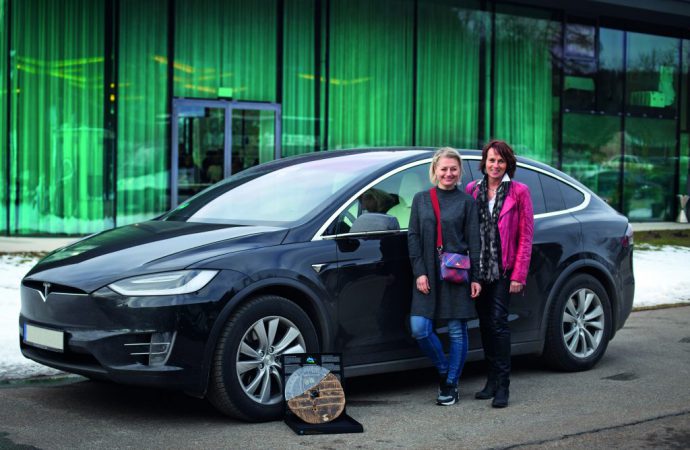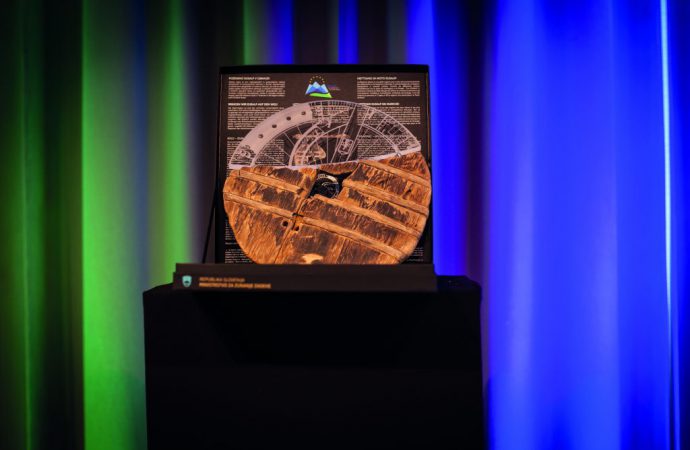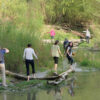There actually is a perpetuum mobile? Figuratively speaking, yes. It is the 5200-year-old Kolo Wheel, the oldest wheel with an axle in world history. We had a look at the original in the Slovenian capital Ljubljana, the place where it was found, and in Innsbruck we witnessed how it still connects and advances countries and
There actually is a perpetuum mobile? Figuratively speaking, yes. It is the 5200-year-old Kolo Wheel, the oldest wheel with an axle in world history. We had a look at the original in the Slovenian capital Ljubljana, the place where it was found, and in Innsbruck we witnessed how it still connects and advances countries and regions within the EU as an important symbol today.
The wheel – a unique creation
Actually, it looks pretty unspectacular. In the showcase, there is a round wooden object, one end of which has been broken off and probably lost. Next to it hangs a stick. But isn’t it the little things that can change our lives drastically? It is the same in this case. The round thing is a wheel with an axle. What makes it so special, however, is its age: it is already 5200 years old and is thus the oldest wheel ever found in human history.
If one is aware of these enormous numbers, this simple object, known under the name Kolo Wheel 5200, has a fascinating and mystical effect on the observer. Its creation is also unique because it does not occur in nature. Author Jürgen Kaube explains it aptly in his book “The Beginnings of Everything”: “The hammer has been explained as an organ projection based on the model of the clenched fist, the millstones from the teeth and the mechanical levers from the arms … But for the wheel – a structure that rotates 360 degrees … – neither the human body nor the environment provide stimulation. The limbs cannot rotate, and even the sun is only round for contemplation, but it does not rotate. The wheel can therefore not have been invented by imitating nature …”
One of the most important cultural assets in the world can be admired in the Ljubljanica river experience and exhibition site near the Slovenian capital Ljubljana. This museum of superlatives is housed in a former factory near the place where the wheel was found. Here the visitor can learn everything about the prehistory and ancestors of this area on the river Ljubljanica up to the present day.
The sensational discovery happened unexpectedly in 2002, when archaeologists took a sample of wood in a drainage ditch of the 5200-year-old Stare Gmanje pile dwelling in the Ljubljana moor near Vrhnika, about 20 km from Ljubljana. There they found the remains of the wooden wheel next to two wooden boats and numerous other finds. When the trench was extended, the matching axle was found.
The wheel has a diameter of 72 cm, is five cm thick and consists of two ash wood planks held together by four wedged oak dowels. The rectangular opening in the middle is intended for fixing the axle. The choice of wood was certainly not accidental, because ash wood is tough and massive and was abundant near the pile dwellings. The axle is made of a piece of oak wood and is 124 cm long. Its end part has a rectangular cross-section and fits into the hub of the wheel. The axle was attached to the wheels with oak wedges, which means that the axle rotated together with the wheel. Similar wooden wheels were also found in Switzerland, as well as in the Federseemoor in Seekirch-Achwiesen in Southern Germany. However, they are smaller and somewhat younger with an age of 5000 years.
How did people feel about the vehicle in their village when it passed through? According to the reconstruction it belongs to a cart pulled by cattle. Were they as astonished as the ladies and gentlemen when they saw the first car? Was it accepted or rejected at first? We don’t know. Imagine, however, that suddenly heavy goods no longer had to be carried. Now timber from the hilly hinterland of the swamp of Ljubljana and the harvest were transported home in a cart. These carts, which were primarily used in hilly areas, can still be found today in some remote areas of
the world. A big step for mankind but also for mobility and technology. Where has the wheel taken us until today? Exactly! Very far!
Tesla and Kolo Wheel – Emission-free mobility with 5200 years age difference
Around 5200 years later, winter 2018. We drive to Austria with the Tesla Model X 100D, more exactly to Innsbruck. The wheel, pardon me, the wheels keep turning, faster now. While the longest travel route of the 5200 years old wheel was about 500 km according to finds, today we can drive around the world with our cars without any problems. Today we are dealing with other problems. Driving is not exactly environmentally conscious. We are now working on moving as environmentally friendly as possible.
This is also one of the goals of EUSALP, whose presidency will be handed over to the Tyroleans today. Seven nation states and 48 regions in the Alps have joined forces to create common goals for the preservation of this beautiful region. Admittedly, this is not always easy, but first steps have now been taken – also thanks to the wheel. Because we know that only together can issues relating to peace and the preservation of Mother Earth be realised and implemented.
The question of future mobility also needs to be solved. There are a few good ideas. All of Austria’s important politicians, including the President himself, Alexander van der Bellen, will travel to the ceremonial handover. One limousine after the other lines up on the VIP parking lot, but there is not a single emission-free vehicle. Our Tesla is an absolute eye-catcher – not only because of its gullwing doors. Some politicians make selfies with the electric car. We ask why there isn’t such a car in their fleet yet. There is no difference in price. A shoulder shrug or the general answer: “The infrastructure is not yet fully developed”. Well, that would be a point to include in discussions. The reaction: an approving and above all thoughtful nod.
There are some genuinely interesting speeches before the presidency is handed over with a particularly beautiful and meaningful symbol called “Wheel 5200”. It is a replica of the Kolo Wheel, the oldest wheel from Vrhnika. The missing piece was not reconstructed, but consists of printed glass. It is the plan of a space station, published in 1929 by scientist Herman Potocnik under the pseudonym Hermann Noordung in “The Problem of Space Travel”. Born in Pula in 1892, the Slovenian is still regarded today as a pioneer and visionary of modern space travel. The space technician died severely impoverished at the young age of 36 in Vienna.
Slovenia has created an important symbol for the EU
Slovenia, which held the presidency first, had the wonderful idea of creating a symbol to set the EUSALP project in motion: “We wanted to combine something existing with something futuristic”, Andreja Jerina explains to us, the National Coordinator EU Macroregional Strategies at the Ministry of Foreign Affairs of Slovenia. They have succeeded completely. Kolo Wheel, the first wheel of human history and the idea of Potocnik were brought to life together and are now rolling towards the future together.
We are going home. What do the Kolo Wheel and the Tesla have in common? Both drive emission-free. It’s just that with the Tesla everything is easier and faster today. For more than 5200 years, the wheel has been moving the world and our lives. Maybe it’s the real perpetuum mobile that people are so desperately looking for. Sometimes things are right before our eyes and we cannot recognize them. Why search for fiction when the existing is already there and just wants to be further developed? The future remains exciting – not least because of the wheel and its mobility.
Mirella Sidro,
journalist, Augsburg







